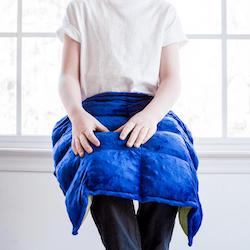Your Cart is Empty
Save up to 20% on all Harkla products & courses during Autism Acceptance Month! Click Here to See the Sale

If you’re a parent of a child with autism, you have spent much time trying to understand the subtleties of what causes or contributes to his stressful, anxious responses. These responses could be outward signs of anxiety like: increased stimming, self-injurious behavior, bolting/eloping/running away, repetitive behaviors, or verbal responses. Or, the anxious response could manifest as physical symptoms that your child may or may not be able to give voice to.
Whether you try to identify patterns of behavior or avoid “triggers,” it’s natural to want to minimize the anxiety in our children.
Children with autism can experience anxiety just as typically developing children do. Separation anxiety, OCD-like perseverations, social anxiety, and sensory-related anxiety are all frequent occurrences in children with autism.
Because of the communication difficulties associated with a diagnosis of ASD, the way these feelings of anxiety manifest may look different, as will the strategies to support the child.
To better understand the connections between autism and anxiety, it is important to consider your child’s sensory system and how sensory overload may be contributing to his overall behavioral and emotional regulation.
While it’s a bit of the “chicken and egg” discussion, it is an important question to consider as we talk about the topic: Given the sensory processing disorders associated with an autism diagnosis, can/do sensory processing difficulties cause anxiety? Or, does anxiety contribute to a sensory-based response?
In our article on the topic of sensory overload and anxiety, we talked about sensory thresholds and, when all of the stimulation becomes too overwhelming, sensory overload.
How much sensory input it takes to reach your threshold depends on your individual sensory profile, whether you over-respond or under-respond to sensory information.

Meltdowns are reactions to feeling overwhelmed and are often seen as a result of sensory overstimulation.
When a person experiences too much sensory stimulation, their central nervous system is overwhelmed and unable to process all of the input. It’s a physiological ‘traffic jam’ in your central nervous system and the sensory overstimulation causes a physiological response and sometimes even a sensory meltdown.
Because many children with autism are unable to self-regulate, sensory overload can result in sensory-based meltdowns.
We know that 75% of children with autism have sensory processing disorder (STAR). When your body is not processing, interpreting, and responding appropriately to the sensory information around you, the fear of not knowing what sensory experiences may arise is enough to cause you to have a heightened arousal level and be anxious about the “what-if’s” or “maybe’s” with new experiences.
In times of anxiety and stress, the sympathetic part of your Autonomic Nervous System produces cortisol hormones and triggers a “fight or flight response.”

When people with autism experience sensory overstimulation, they are unable to regulate the sensory inputs from their environment and their bodies perceive these inputs as threats.
It is important to view sensory meltdowns as physiological responses and not controllable behavioral reactions. You cannot expect logical, rational responses to sensory situations when your body is perceiving those situations as threatening.
Video modeling, social stories, check-off lists, and visual activity/task schedules will be helpful in communicating to your child what is planned, and what the expectations will be.
Social stories that walk a child through the plan, from beginning to end, will offer predictability and a sense of control that may reduce anxiety
Routine sensory diet activities are important to support regulation across the day. Some parents find it helpful to schedule “quiet time” for their child, in order to allow for the downtime proactively before the activity of the day gets to be too much.

Incorporate deep touch pressure into your child’s day whether it be through weighted wearables, compression garments, weighted blankets on his bed, or weighted lap pads in the classroom.
The increased proprioceptive input has positive effects on reducing anxiety.
For more information on DTP, read here.
Signs of distress can be nonverbal indicators that your child is quickly becoming anxious or overstimulated and needs your help regulating before reaching the point of meltdown.
Create a safe space to calm down or regroup. Sensory deprivation or quiet areas change the amount of sensory input the child is exposed to. This can be very helpful in situations where sensory overload contributes to anxiety.
To read more about creating sensory rooms, checkout our article here.
Create a portable sensory toolbox to reduce sensory sensitivities and improve tolerance to stressful, noxious situations.
Consult your speech therapist or teacher on what assistive technology may support your child’s communication of needs, wants, or emotions. This could be as simple as a laminated icon-based communication board or involve AAC-specific programming related to his anxiety.
If your child is able, explore self-soothing strategies such as slowly counting to ten, deep breathing, meditation, or visualization techniques.
Try additional types of support such as Cognitive Behavioral Therapy, Exposure Therapy, and pharmacological interventions that have been researched specifically for children with autism and anxiety.
Explore redirecting any potentially harmful behaviors through the use of fidgets or manipulatives when anxiety manifests through repetitive movements.
Check out our 10 favorite fidget toys here
Kids with autism experience anxiety as many typical children do, but the way that the anxiety manifests or is expressed looks different based on individual communication and sensory processing skills associated with an autism diagnosis. It is important to approach your child’s anxiety from a multi-faceted approach and consult his therapeutic team to determine the appropriate interventions.
Hey Peggy,
That sounds like it can be a struggle. I’m really sorry about that! I hope you found some of our tips in our article helpful!
All the best to you,
Nicole
Harkla
Our adult autistic daughter repeats her question over and over we think it is stimming but she expects a answer from us even after we have already answered it and then has a meltdown and then becomes aggressive
Comments will be approved before showing up.



Cat
November 08, 2019
My adult son repeats his self Also when he does that I tell him to stop repeating I think this happens a lot among people with autism